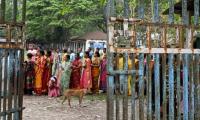Although it only has a 0.5 percent share in the China-Pakistan Economic Corridor, Balochistan has witnessed the most number of CPEC-related inaugurations and seminars since 2013. However, they have been much exaggerated. For instance, a primary school worth Rs40 million in the poverty-stricken parts of Gwadar’s Faqeer Colony was inaugurated by PM Nawaz Sharif.
The province is still under Islamabad’s ‘iron curtain’ policy and no journalist is permitted to independently document the public response towards CPEC or other projects. By creating such hype, the government is trying to divert attention from the province’s critical and underlying structural faultlines – such as massive corruption, nepotism, the mismanagement of resources, high levels of poverty, unemployment and oppression.
All this flimflam around CPEC has created the impression among those who are disadvantaged that the province’s appalling socio-economic ills will fade within a limited period of time. As a short-term strategy, it is not a bad idea to keep people motivated towards a mirage. But illusionary scenarios that have no solid basis will lead to frustration and widen the distrust between the Baloch populace and the state.
In the CPEC projects, energy is the dominant component. Around 70 percent of the $51 billion CPEC projects comprise coal, wind, thermal and hydel power projects, which are expected to generate over 16,000 MW by 2017. Out of 13 CPEC energy priority projects, six are located in northern and central Punjab and six are situated in Sindh; over 60 percent progress has been made on them. Khyber Pakhtunkhwa has one project and five percent progress has been made on it.
Balochistan has no projects in CPEC’s energy basket as the Gadani Energy Park and Gwadar power projects were shelved long ago. So the province could, ideally, have massive transmission lines in CPEC to receive load from energy projects that are under construction in Punjab and Sindh. But, surprisingly, there is not a single electricity infrastructure to transmit power to Pakistan’s downtrodden and energy-starved regions, including most of Balochistan.
Unfortunately, CPEC-generated energy will not provide any relief to consumers in Balochistan. The existing transmission and distribution network in the province is inadequate and even if Islamabad generously offers surplus electricity from CPEC’s energy projects in Punjab and Sindh, Balochistan does not have the capacity to absorb energy beyond 500MW.
Out of 5,110km of National Transmission and Dispatch Company’s 500KV transmission line, Balochistan only has a 27-kilometre circuit length of the 500kv transmission line in the province. According to Hussain Ahmad Siddiqui, ex-chairperson of the State Engineering Corporation, the current power demand of Balochistan is around 1,650MW. But it is being supplied between 400MW and 600MW, resulting in massive electricity shortages. Persistent loadshedding of between 12 to 18 hours in major towns, excluding Quetta, is a matter of routine regardless of the season.
In CPEC’s energy component, there are two transmission lines worth $4 billion. But these are not for Balochistan. The two transmission lines will run from Matiari to Lahore and Matiari to Faisalabad. They will transmit close to 4,000 MW of electricity to central and northern Punjab. The situation in the rural areas – where 85 percent of the 13.16 million-strong population lives – is worse as electricity is available only for four hours on a daily basis. There are some areas in Balochistan which are not even linked with the national or regional grid systems. In fact, only a small section of the population has access to electricity. More than 6,000 applications for new electricity connections are still pending.
CPEC is a game-changer and will affect economic growth, employment and social development in some districts of the prioritised provinces. But projects under CPEC will have no visible impact on Balochistan due to poor planning and designing, the discriminatory allocation of projects and the over-centralisation of the initiative.
Like energy projects, Balochistan will hardly benefit from activities that are taking place in Gwadar. Based on the current constitutional arrangements, revenue generated from ports and airports will be collected by the federal government, not the provincial government. Initiatives such as the Special Security Division (SSD) project, the Gwadar Security Task Force and the navy’s special ‘Task Force-88’ (TF-88) have provided little or no employment to locals in the province.
The aim should be to create stakes for the people of Balochistan in the system by raising a representative force recruited from relevant districts of the province. Instead, job vacancies in the SSD, GST and TF-88 are being filled by non-civilian personnel.
Projects in Punjab and Sindh have a different level of impact on the economy and social development. Only the 27 kilometre-long Orange Line Metro will initially benefit around 250,000 passengers every day – which will be increased to 500,000 passengers by 2025. The metro line will increase mobility, accessibility, efficiency and productivity. It has already generated 10,000 direct and indirect jobs and provided an impetus to central Punjab’s small and medium enterprises. But despair and disappointment are already visible through discussions and writings on Balochistan.
If Islamabad continues to rule Balochistan with an iron fist, the poverty-stricken province will witness more misery in the coming days. It is unfortunate that the space for dialogue, debate and ideas has been stifled by threats and violence. The powerful establishment views all logical concerns about the province as a threat to its 60-year-old status quo which has only empowered a group of elite, bureaucrats and security forces at the cost of millions of impoverished, unemployed and school-starved people of Balochistan.
Fancy seminars and endless trips to Gwadar will not address the appalling situation and the concerns of millions of people who live in over 30 districts and 7000 villages. Islamabad has to get rid of its policy of deception and initiate dialogue to examine and understand Balochistan’s real challenges.
The writer is a former senator from Balochistan. Email: balochbnp@gmail.com
A woman walks past a building of the International Monetary Fund. — AFP/FileThe annual and spring meetings of the...
Late Benazir Bhutto's daughter Asifa Bhutto Zardari addresses the Christian community in Bihar Colony on January 23,...
Representational image. — PexelsWater is an important scarce natural resource that is required for several everyday...
Pakistani employees of online marketplace company Kaymu at work in Karachi. — AFP/FileThe true spirit of development...
India uses Afghanistan as a backstage area to carry out terrorist attacks against Pakistan
Another report by the Pakistan Institute of Peace Studies states that 78 per cent of attacks have been carried out by...







